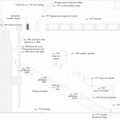
To find where the stair’s landing was located during Madison's era, evidence for how the landing’s framing was supported was identified on the walls of the North Passage. Much like shelves and door headers, evidence for the location and height of the landing could be provided by pockets cut into the masonry by the carpenter. One such pocket was found on the eastern wall. This pocket provided the height of the landing and gave some indication as to the size of the framing. Additional evidence for the landing was provided by nailers that were used to secure the ca. 1797 baseboard that ran along the landing. Other evidence, such as the size of the joists used in the ca. 1797 house, allowed the restoration architects to develop an accurate design for the landing.

©The Montpelier Foundation
|
|
A section of the ca. 1797 framing that showed where the stair ended on the second floor. |














